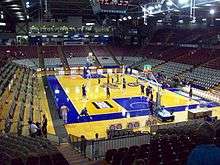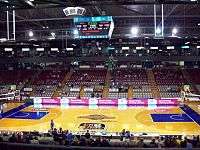Titanium Security Arena
|
Brett Maher Court The House the 36ers Built The Powerhouse | |
 Looking east toward the main entrance, 5 April 2009 | |
| Former names |
Clipsal Powerhouse (1992–2002) Distinctive Homes Dome (2003–2009) Adelaide Dome (2009–2010) Adelaide Arena (2010–2015) |
|---|---|
| Location | 44A Crittenden Road, Findon, Adelaide, South Australia, Australia |
| Coordinates | 34°54′1″S 138°32′46″E / 34.90028°S 138.54611°ECoordinates: 34°54′1″S 138°32′46″E / 34.90028°S 138.54611°E |
| Owner | Scouts SA & SA Church Basketball[1] |
| Operator | Arena Stadium Management |
| Capacity | 8,000 |
| Record attendance | 8,127 - 2014 NBL Grand Final Game 2, Adelaide 36ers vs Perth Wildcats[2] |
| Surface | Canadian Maple |
| Construction | |
| Broke ground | 1991 |
| Opened | 4 April 1992 |
| Construction cost | A$16m |
| Tenants | |
|
Adelaide 36ers (NBL) (1992–present) Adelaide Lightning (WNBL) (1993–2005, 2008–present) Adelaide Thunderbirds (CBT) (1997–2000), (ANZ) (2016), (NNL) (2017–) Adelaide Ravens (CBT) (1997–2000) | |
The Titanium Security Arena (TSA), formerly known as the Clipsal Powerhouse (1992–2002), Distinctive Homes Dome (2003–2009), Adelaide Dome (2009–2010), and Adelaide Arena (2010–2015),[3] is an 8,000 seat, Australian privately owned multipurpose indoor sports stadium located in Findon, an inner western suburb of Adelaide, South Australia.
It is the home stadium for the Adelaide 36ers of the NBL and the Adelaide Lightning of the WNBL while it is the alternate venue for Adelaide's National Netball League (Suncorp Super Netball) team the Adelaide Thunderbirds.
Although it can be a multipurpose venue catering to both sports and other events, the Titanium Security Arena is currently the largest arena in Australia primarily built for basketball, and as of the 2016–17 NBL season is the 6th-largest out of 11 venues currently used in the league, though it remains the only basketball specific venue. The arena is also the largest venue currently used in the WNBL and the 4th largest to be used in the upcoming Suncorp Super Netball season in 2017 (the Thunderbirds used the Arena in the previous ANZ Championship in 2016).
Although the arena has not been known as the Clipsal Powerhouse since 2002, many fans in Adelaide still associate the name with the venue and often refer to is as "The Powerhouse".

Features
Sideline seating on both sides of the main court is retractable and can be moved back and hidden to reveal a further 2 basketball courts for tournaments and practices and a floor space of 2,190 m² (other than game days, the seating is usually fully retracted). The arena seats 8,000 with a full seating bowl and an upper deck stretching from the south west to south east corners as well as limited seating on the northern concourse located beneath 19 corporate suites which stretch from the north west to the north eastern corners. Formerly known as the Apollo after the 36ers original home Apollo Stadium, the restaurant which is open to the public on 36ers game days, is now known as the Scouts Deck after the co-owners of the arena, Scouts SA. The surface of the arena is Canadian Maple which was installed at a cost of approximately AU$300,000. The floor is set approximately five metres below ground level, giving the building a lower overall profile with spectators entering the arena above the main seating bowl. The arena also has parking spaces for up to 2,500 cars.[4]
The seating at the western end of the arena between the home and away dressing room tunnels is also retractable with the 36ers in recent years using this area as a VIP lounge, though for games such as NBL Grand Finals the seating in that area remains in place to increase spectator capacity to the full 8,000. With the VIP lounge in place the arena's capacity for basketball is reduced to 7,800.
Titanium Security Arena also features a state of the art above court video scoreboard that was erected in 2016 to replace the old analog scoreboard that had been in place since 1992.
History
The Arena has been the Adelaide 36ers' home venue since 1992 and the Adelaide Lightning's home on and off since 1993.
The arena was built to replace the 36ers former home, the Apollo Stadium, which only seated 3,000 people in cramped conditions. Built in 1969, Apollo had been superseded as Adelaide's major indoor venue by the opening of the 12,000 seat Adelaide Entertainment Centre, in 1991 and while popular opinion believed the 36ers would move to the AEC following the success of the Brisbane Bullets, Perth Wildcats and Sydney Kings who had all made the move to their cities larger entertainment centre's and were attracting record crowds, both the 36ers and the Basketball Association of South Australia desired to own the venue they played in, and to also have a permanent home for basketball in the state (the motivation also included not having to pay hiring costs or be subjected to last minute date changes due to booking clashes).
Sporting events
Basketball
The 36ers opened their new AU$16 million, 8,000 seat home on 4 April 1992 with a 106–84 win over the North Melbourne Giants in front of a capacity crowd. The Clipsal Powerhouse was declared open by then Premier of South Australia and 36ers fan John Bannon (the Premier had been a regular spectator at 36ers games at Apollo). The week before its opening had seen an open day for the new venue with a reported 24,000 fans filing through on the day to see the 36ers train. As a result of that day the 36ers sold some 6,000 season tickets for the 1992 NBL season. Top scoring for the 36ers against North Melbourne were Butch Hays (26 points), Mark Davis (25) and Mark Bradtke (21). Making his debut for the Adelaide 36ers was 18 year old local guard Brett Maher who played 24:45, scoring 11 points and grabbing 7 rebounds. Playing his first game for the Giants after 10 seasons with the 36ers, was Adelaide born guard, "The Iceman" Darryl Pearce.
Since its opening the arena has played host to 7 NBL Grand Final games in 1994 (1 game), 1998 (1 game), 1999 (games 2 and 3), 2002 (games 2 and 3) and 2014 (1 game), with the 36ers winning all games except the opening game of the 1994 series against a North Melbourne team containing then past and future 36ers championship players, Darryl Pearce and Paul Rees, and Game 2 of the 1999 series against the Brian Goorjian coached Victoria Titans. The arena has also hosted the NBL All-Star Game in 1995 and 2006–07. Adelaide 36ers club MVP Robert Rose was named the All-Star Game MVP in 1995.
The NBL revived the All-star Game in 2012, having last played it in Melbourne in 2007–08, and it was that the Adelaide Arena would play host to 2012 NBL All-Star Game played on 22 December. Adelaide 36ers centre Daniel Johnson was named as starting centre for the South Stars team, while 36ers players Mitch Creek and Stephen Weigh were named as participants in the Slam Dunk competition and 3-Point Shootout respectively.[5] Creek was forced to pull out of the Dunk competition due to a season ending Achilles tendon injury, while Weigh would win the 3-Point Shootout. The South All-Stars defeated the North All-Stars 134–114 in front of 4,523 fans (outside temperatures of 34.5 °C, and Sunday Christmas shopping were blamed for the low attendance). The 2012 All-Star Game was the third to be played at the Adelaide Arena, tying it for the most times hosting the event with The Glass House in Melbourne (1988, 1989 and 1991) and the Sydney Entertainment Centre (1994, 1997 and 2005).
On 31 January 2009 the 36ers celebrated their 200th NBL victory at The Dome when they defeated long-time rivals, the Perth Wildcats, 107–92.
On 7 February 2009 in front of a sellout (and over capacity) crowd in excess of 8,000, the main court of the Dome was renamed The Brett Maher Court in honor of retiring Adelaide 36ers captain Brett Maher who played his entire 526-game NBL career with the 36ers and only ever had The Dome as his NBL home court. Brett Maher was 36ers captain during their 1998, 1998–99 and 2001–02 NBL championship seasons, winning the Grand Final MVP in 1999 and 2002, and also appeared in the 1994 Grand Final series. Maher also played for the Australian Boomers, playing over 100 games for his country from 1995–2004 including captaining the team at the 2001 Goodwill Games in Brisbane as well as being a member of the 1996, 2000 and 2004 Summer Olympic Games teams. The 36ers won the game 102–91 over the New Zealand Breakers with Maher one of Adelaide's better players on the day, leading from the front with 17 points.[6][7]
The Adelaide Arena has also played host to Boomers and Opals games against various visiting nations and other touring teams, including the opening game of a five-game series between the Boomers and Magic Johnson's All-Stars, who included former NBA players such as captain/coach Johnson and three-time NBA All-Star Mark Aguirre who top scored with 32 points, on 7 March 1995. In front of almost 8,000 fans, the All-Stars defeated the Boomers (who included 36ers players Mark Davis, Brett Maher, Mike McKay, Chris Blakemore and Brett Wheeler) 113–98.[8]
The Harlem Globetrotters have also played at the Adelaide Arena, the most recent being on 1 November 2013.
Netball
When it was opened in 1992 the Powerhouse also became the home of major netball games played in South Australia which had previously been played at Apollo, with the State league Grand Final being played there until 2000. The Australian Netball Diamonds have used the arena for test matches and from 1997 until the opening of the 3,000 seat ETSA Park (now Priceline Stadium) in 2001 was the home of the Adelaide Thunderbirds and Adelaide Ravens who played in netball's Commonwealth Bank Trophy.
With netball's popularity increasing in recent years, most major games in Adelaide, including the 2010 ANZ Championship Grand Final (which attracted a record crowd of 9,300 for a game of netball in South Australia), as well as international matches, have been played at the larger Adelaide Entertainment Centre. As of 2016, the Arena is once again the alternate venue for the Adelaide Thunderbirds with the Entertainment Centre only hosting international games.

Renovations
During a long road game stretch for the 36er's in January 2016, ownership undertook an extensive renovation process. A new, state of the art above court video scoreboard was erected to replace the old analog scoreboard (see picture at right) which had been in place since 1992; new lighting was added and sound quality of speakers was highly improved.
Ownership
The Dome was purchased by Eddy Groves (ABC Learning CEO and Brisbane Bullets team owner) and Mal Hemmerling in 2006 for A$3.95 million.[9] In 2012, the Commonwealth Bank took possession of the arena after Eddy Groves had defaulted on the loan. It was reported at this time, that the bank had granted the Adelaide 36ers use of the venue for the 2012–13 season.[10]
On 3 April 2013, it was announced that SA Church Basketball and Scouts SA had become joint owners of Adelaide Arena,[1] ensuring it remains the home of South Australia’s national basketball teams, the Adelaide 36ers and the Adelaide Lightning.
In 2015, the Arena became known as Titanium Security Arena under the operations of Arena Stadium Management and its Chairman Bruce Spangler.[11][12]
Restrictions
Despite the arena's ability to host more than just sporting events such as basketball and netball, the Government of South Australia placed restrictions on the venue's use since its opening in 1992. Due to the government owning the 12,000 capacity Adelaide Entertainment Centre which opened in 1991 (and their fear that the A$44m venue would be a white elephant), the Adelaide Arena was unable to be used for such events as concerts, with most major international musical acts having to perform at the AEC, or Adelaide's outdoor venues such as AAMI Stadium, Memorial Drive or the Adelaide Oval.
Those restrictions were lifted in December 2014 allowing the Arena to host no-sporting events including music concerts. The set up for concerts at the arena involves retracting the northern bowl seats to allow for a stage with general floor seating covering the Brett Maher Court.
References
- 1 2 Nagy, Boti (3 April 2013). "Adelaide Arena's future secured". Adelaide Now.
- ↑ Adelaide 36ers beat Perth Wildcats 89-84 in NBL Grand Final game two
- ↑ "Adelaide Dome". Austadiums. 4 November 2010. Archived from the original on 15 June 2011. Retrieved 2 June 2011.
- ↑ Adelaide Arena Venue Details
- ↑ NBL brings basketball All-Stars to Adelaide
- ↑ Brett Maher Career Highlights
- ↑ Brett Mahers Final* Home Game
- ↑ 1995 Australian Boomers vs Magic Johnson's All Stars - Adelaide
- ↑ Nagy, Boti (14 August 2006). "All steady says Eddy". The Advertiser. Retrieved 2008-05-03.
- ↑ Future in the balance as Adelaide 36ers bank on an answer on venue lease
- ↑ NBL backs new Adelaide ownership group
- ↑ Syndicate of business people buys the Adelaide 36ers
External links
- Titanium Security Arena official website
- Titanium Security Arena at Austadiums
- Titanium Security Arena seating arrangement
